Giving just the right amount of electrical power to your Commodore 64’s is vital to ensure a stable operation. Voltage drops may give rise to stability issues while too much voltage will undoubtedly fry the delicate chips on the old C64 motherboards. The latter is enevitable if an original C64 power supply unit (PSU) is being used. It may not not happen today nor tomorrow, but it will break down eventually and cause damage to the old chips! To overcome these unwanted power surges or increases in voltage levels, several options exist. A semi-cheap way is to add a so-called over voltage protection circuit like Ray Carlson’s Computer Saver (link) to the power cable of an original C64 PSU. This is what I have been using for the last five years or so. Another approach is to simply pay a little more and get a modern-day Commodore 64 PSU with a build in over voltage protection circuit.
Several manufacturers produce brand new Commodore 64 power supplies. One of them is Polish based Electroware (www.c64psu.com) which also makes power supplies for the Commodore 128 and the Amiga. A few years back, I did a review of one of their early models (link). Back then, I had some concerns regarding especially the 5VDC line showing values as low as 4.73VDC in a standard C64. A value which I found to be a bit on the low side for my taste. The 9VAC line yielded values of 11.50VAC which I found to be a little high. I know, I’m being overconcerned… In this context, I must add that I did not experience any instability issues or any peculiar behaviour in the tested machines during my tests with the Electroware power supply.
So when I was asked by Electroware to do another review of their newly updated (10th revision) Commodore 64 power supply as well as their new PRO model, I immediately accepted. Apparently, they listened to some of the comments from their users and updated the hardware. According to Electroware, the upgraded versions now have identical voltage values (5VDC and 9VAC) to those of the original Commodore 64 power supplies. It is always extremely nice when manufacturers listen to the input from their users and try to implement them in future revisions of their hardware. This certainly builds trust among end users. Kudos Electroware!
Electroware provided me with their standard C64 PSU model and the more advanced C64 PSU PRO model for this review. Both models can power any original Commodore 64 and have support for the Commodore 128 with an adapter cable (it costs 8.99 Euro and is sold seperately).
My final thoughts can be found at the end of the post. Here are also the arguments why one of the Electroware power supplies has taken the place of my original beige Commodore 64 power supply in my main Commodore 64 setup.
What’s in the Boxes?
The power supplies came neatly packed inside identical sturdy cardboard boxes with heaps of paper filling. A manual and a detachable power cable were also found inside the boxes. This makes it really easy to add longer mains cables if needed (this option is not available for the US versions of the power supplies!).
More Electroware Power!
Original Commodore 64 power supplies have never been really powerful. The original C64 power supplies were specified at 5VDC@1.5-1.7A and 9VAC@1A. Both power supplies under review here can deliver significantly more power than the original C64 PSU’s and the standard C64 PSU model has even more power available than the version that I have tested previously. The standard C64 PSU model and the C64 PSU PRO model can each deliver 4.0A and 3.0A respectively from the 5VDC line. The 9VAC lines are unchanged at 1.1A. However, the only device which uses the 9VAC line is the cassette motor transistor amplifier and on Revision B motherboards (Assy 250425, 250441 & 250466) it is also used for the RF modulator. So no real need to beef up the 9VAC line. However, according to Electroware, the unloaded AC voltage value should have dropped closer to the 9VAC values found in the original Commodore 64 power supplies (more on that later…).
On top of the available 5VDC power, the C64 PSU PRO model also comes with an extra outlet socket (12VDC@0.6A and 5VDC@1.0A) for powering 1541-II and 1581 diskette drives. To take advantage of this, the C64 PSU PRO model comes with an extra cable for powering those devices if needed. Generally speaking, the updated and new power supplies from Electroware seem to be able to deliver heaps of power – more power than needed even with some really power hungry peripherals added. I am personally a huge fan of over-engineering things… Well done Electroware!
Power Supply Test Bench
There are numerous ways to test power supplies. As I do not own special equipment to measure e.g. ripple noise I therefore simply used my multimeter for the voltage tests. For comparison, I used voltage values from five original Commodore 64 power supplies (a variety of beige and browns orignal C64 PSU’s) as well as a state-of-the-art power supply from Ray Carlsen as found in this post (link). As power supplies yield different internal voltage levels compared to voltages measured inside what they are powering (e.g. a Commodore 64), all measurements were done directly on a C64 motherboard. I therefore used an Assy 250469 short board Commodore 64 for all my tests. The machine had no peripherals attached (e.g. 1541U-II, SD2IEC, tape deck, accelerators etc.) so it was as basic as it could be.
All power supplies were attached to the Commodore 64 and turned on (loaded) for at least 15 minutes before I did the measurements to ensure that they were warmed up. For the 5VDC measurements I used, among others, pin 14 of chip U22 7406 on the motherboard. The 9VAC values were measured directly at the power plug.
The Standard C64 PSU model
The standard C64 PSU model is a brand new replacement power supply for the Commodore 64 (and Commodore VIC20) home computers. It simply replaces the original (and unreliable!!) Commodore power supplies. The standard C64 PSU model has more than twice the power (20W vs. 7.5-8.5W) compared to the original C64 power supplies. In other words, it should be more than enough for most users including Commodore 128 owners (the latter needs a special cable adapter to work!).
The front of the PSU has a nice power switch to save power when not using the computer. It can also be used instead of the main power switch of the Commodore 64 which is known to fail (link, link). A green LED lights up inside the case when the device is turned on. I would have preferred the LED to be placed at the front of the device or integrated into the power switch. But that is probably just me 🙂
The device also boasts multiple active and passive over-current and over voltage protection circuits to ensure that the delicate components of the Commodore 64 is always protected. According to Electroware, the over voltage protection circuit works fast, is reliable and is based on a crowbar protection circuit and a TVS diode. The circuit is set to trigger around 5.3VDC measured on the motherboard which sounds pretty good to me.
Measurements
I obviously had to take the PSU apart to see what gems were hidden inside the black plastic case. Doing this will void the waranty of the device, so please keep this in mind before opening up the case! The 5VDC line uses a Mean Well IRM-20-5 transformer which provides up to 4A as expected. Thus, during normal operation a Commodore 64 will only load the PSU about 25%, which reduces the output ripple significantly. The info of the 9VAC trafo was hidden by the green PCB so I could not see what specific piece of hardware was used.
The previous test of the standard C64 PSU model had quite low 5VDC values of 4.73VDC and a bit high 9VAC values of 11.50VAC. According to Electroware’s homesite (www.c64psu.com) the 5VDC line of the current version of the standard C64 PSU should be very close to 5VDC and the 9VAC line should have been lowered to about 10 VAC which is also very reasonable for an unloaded system. These values are in concordance with the values I measured in the five original C64 power supplies (4.99-5.03VDC and 10.19-10.63VAC).
Measurering the voltages of the standard C64 PSU model, I consistently got values of around 5.02VDC and 10.29VAC. Exactly the same as the various original C64 PSU’s I also tested. Even though I could not see the specification on the 9VAC transformer, it certainly seems like the un-loaded current is right on target this time. Now, users (including myself) cannot say that either of the output voltages are any different from the original C64 PSU’s. Only Ray Carlson’s PSU showed a lower value of about 9.4VAC… But hey, I view the Electroware values as a being spot on!
Price
The standard C64 PSU model costs 30.99 Euro + shipping from Poland. The type of mains cable can be chosen on the product page.
Going PRO!
The C64 PSU PRO model is also a modern-day replacement power supply for the Commodore 64/VIC20 (and the Commodore 128 with an adapter cable). It has an extra power outlet (and cable) to simultaneously power a 1541-II diskette drive (+support for a 1581 floppy drive).
The front of the PSU holds a red power switch to turn off the device when not in use. It can also be used instead of the main power switch on the Commodore 64 which is known to fail (link, link). Two LED’s inside the case show the status of the 5VDC line (green) and the 12VDC line (orange). Once again I would have preferred the LED’s to be placed at the front of the device. But that is simply a design decision and it obviously has no impact on the functional behaviour of the PSU. So certainly not a biggie.
The device also has multiple active and passive over-current and over voltage protection circuits to ensure that the delicate components of the Commodore 64 is always protected. Again, no worries about zapping the components of my precious retro hardware.
Measurements
Once again I had to take the PSU apart to see what parts were hidden inside. As mentioned before, this will void the waranty of the device!
My measurements of the C64 PSU PRO model consistently yielded values of 5.04VDC and 10.50VAC. Once again, very similar to the five original C64 power supplies that I also tested the five (4.99-5.03VDC and 10.19-10.63VAC). The C64 PSU PRO model simply got perfect voltages in relation to the original dittos! As the specs of the 9VAC transformer was hidden under the green PCB, I therefore could not tell what specific trafo is used.
Adjusting the 5VDC line
As stated previously, the C64 PSU PRO model also has the possibility to adjust the 5VDC line to exactly 5VDC. So if more peripherals are added to the computer (e.g. REU, SuperCPU etc.) any drops in power can be adjusted using a small potentiometer positioned at the bottom of the power supply. All there is needed is removal of a small rubber plug and then a small screw driver is used to turn a potentiometer. According to the Electroware homesite, the output can be adjusted between 4.75-5.25VDC depending on the specific load of the PSU. I used the potentiometer to adjust the 5VDC to well, exactly 5VDC 🙂
I also tried turning the potentiometer to its maximum and minimum positions to see what happened – I just had to, right? This yelded voltages of 4.89-5.37VDC respectively. In other words 0.5VDC like stated by the manufacturer and still within reasonable safe limits. Thus, everything has been perfectly dimensioned to ensure that the motherboard chips will never be fried unintentionally even at maximum attainable voltages with the C64 PSU PRO model.
I also added Ray Carlson’s computer saver (over voltage protection device) between the C64 PSU PRO and the Commodore 64. I figured it was a nice (and safe) way to test that device as well. According to Ray, it should cut the power if the voltage exceeds 5.4VDC. I never managed to increase the voltage to more than 5.27VDC before the device cut the power and the red over voltage LED on the cable lighted up. Thus, Ray’s computer saver works flawlessly 😉
Price
The C64 PSU PRO model costs 54.99 Euro + shipping from Poland. The type of mains cable can be chosen on the product page.
Final Thoughts
Both power supplies from Electroware fulfill their purpose to safely power all original Commodore 64 versions. The power supplies also provide ample power to drive even the most power hungry Commodore 64 setup without breaking a sweat. Even with the addition of a 1541-II diskette drive, the C64 PSU PRO model has plenty of power to drive both machines. This is due to an intelligent DC power distribution which actively redirects the power between the 5VDC and 12VDC lines whenever needed.
Both power supplies also use the same compact sized cabinet, they both run ice cold and they have integrated safety circuits to prevent any over voltage disasters. The black plastic cases seems sturdy, the electrical components are of a decent quality and the cables and plugs feels like they will last for a very long time. The engineers of Electroware have done a tremendous job updating their already great and sturdy Commodore 64 power supplies. Bying one of their power supplies is really a no brainer! A true buy and forget C64 product… Just plug it in and don’t worry about frying your delicate Commodore 64 chips due to high voltages or having computer instabilities due to lack of power.
So the big question is which version to choose? The standard C64 PSU model or the advanced C64 PSU PRO version? In my opinion the short answer is: go with the cheapest version! I can highly recommend bying the standard Electroware C64 PSU model. It’s relatively cheap (30.99 Euro + shipping), it has a reliable voltage over protection feature, it comes in a small sturdy plastic case and it provides more power than you will ever need even if adding power hungry peripherals. The 5VDC and 9VAC lines both exhibit voltage values that are spot on in compariosn to the original C64 power supplies and I’m sure they will never give rise to any instability issues in any Commodore 64 system.
On the other hand, the Electroware C64 PSU PRO model is a true high-end product aimed at the Commodore 64 enthusiast with more devices than are really needed (most of us fall into that category, right?). The price is almost twice the price of the standard C64 PSU model. However, the extra features come at a resonable cost. In my opinion, the main reason to buy the C64 PSU PRO model is to use it to power a 1541-II diskette drive (or the possibility to also power a Commodore 128) and to get rid of its original power supply (that PSU may also be unreliable…). The C64 PSU PRO model is also packed with more than enough power to drive any Commodore 64 setup, but with the added possibility to adjsut the 5VDC line to an exact value if any drops in voltage should be detected.
So what version would I get? Regardless of the above arguments and the fact that I don’t even own a 1541-II diskette drive (nor a 1581 drive…), I would of course get the PRO version 🙂 Reason being that I just love the idea of being able to adjust the 5VDC line to meet my exact power needs. Do I have any power hungry accelerators or expansion cards that call for tweaking the 5DC line? Well, no not right now, but I could in the future and in that case I’ll be ready to crank up the voltage to exactly 5VDC 😉
Anyways, the Electroware C64 PSU PRO model now drives my main Commodore 64 setup in my basement…
The power supplies, regardless of version, both have a level of quality that will serve most Commodore 64 users for years to come. Electroware have listened to their users (including me) and have implemented some of the comments and inputs to increase the reliability, stability and security of their power supplies. All things that users should expect from a modern-day Commodore 64 power supply. I can therefore highly recommend both power supplies tested here. Nicely done Electroware! Nicely done!
Both power supplies reviewed here can, along with the rest of Electroware’s range of hardware, be found at www.c64psu.com.
© breadbox64.com 2020

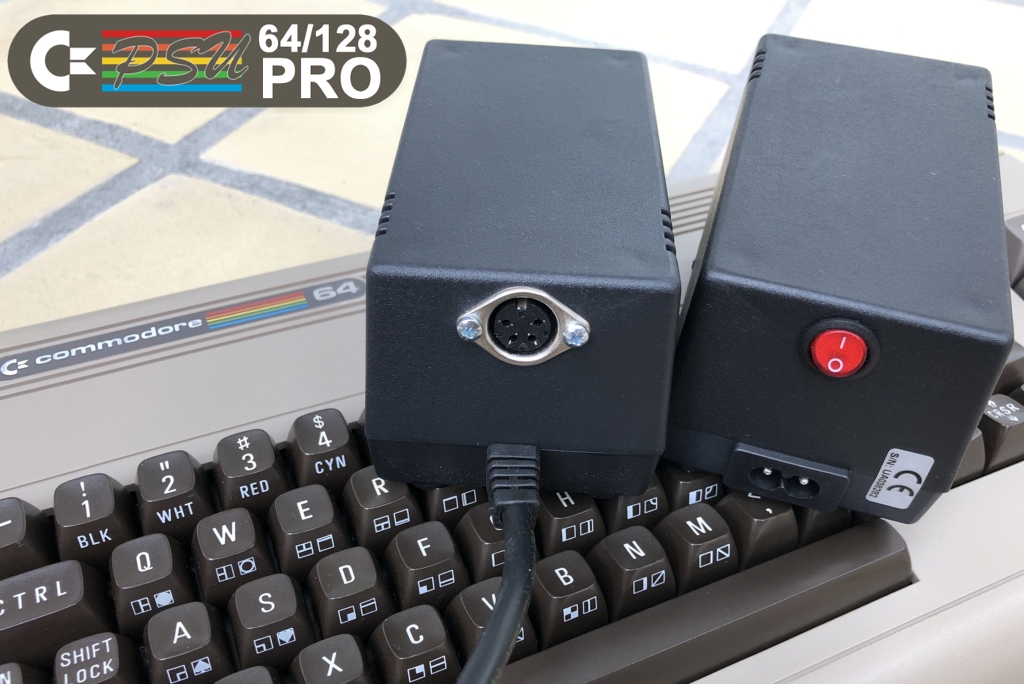
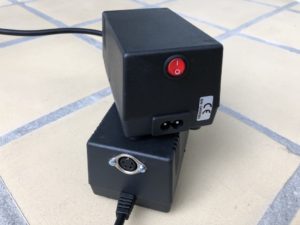
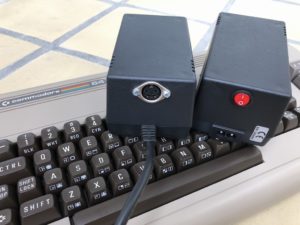
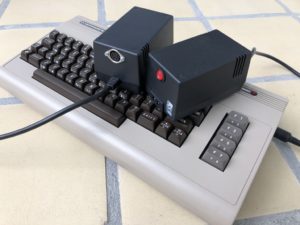

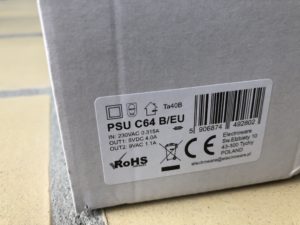
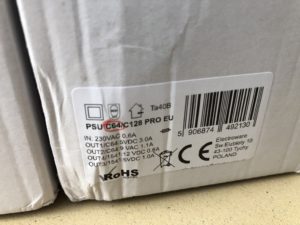

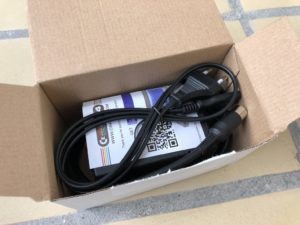
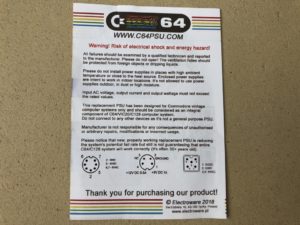
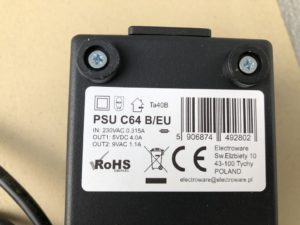
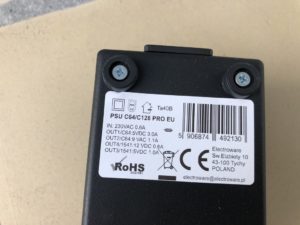
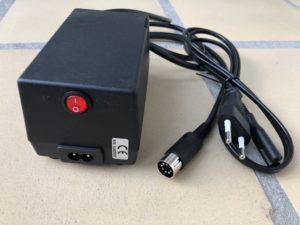
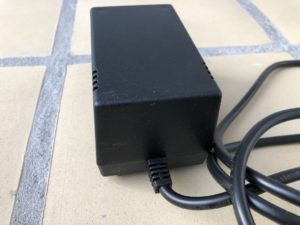
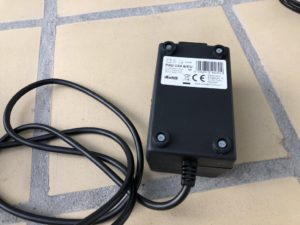
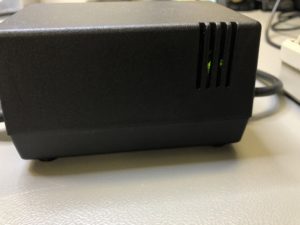
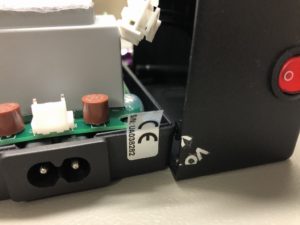
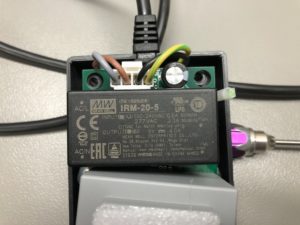
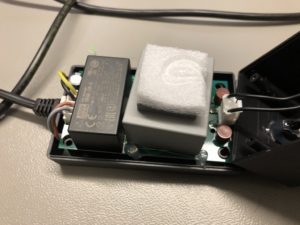
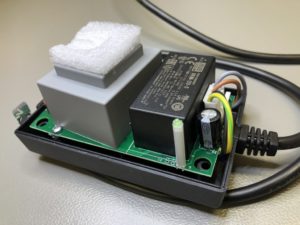
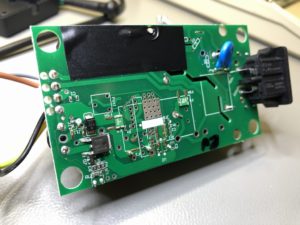
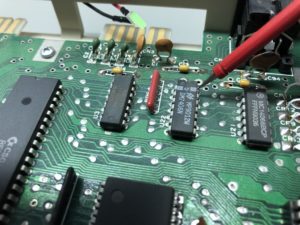
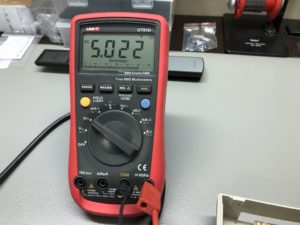
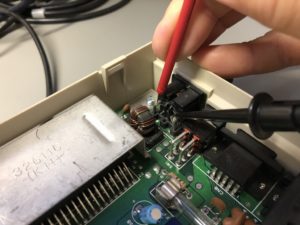
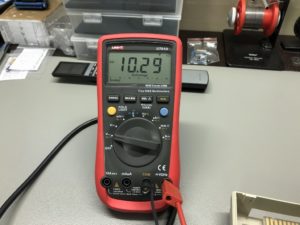
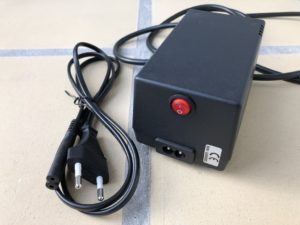
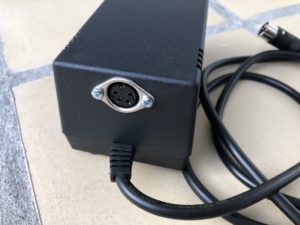
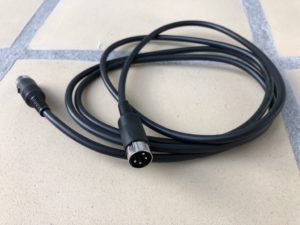
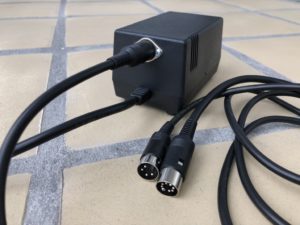
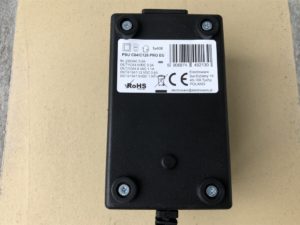
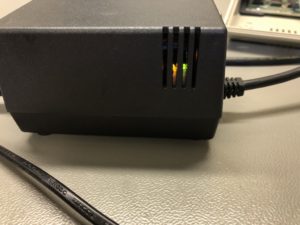
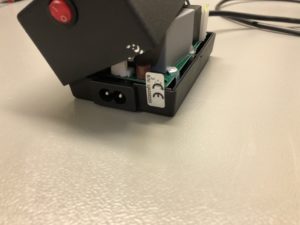
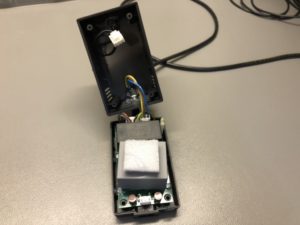
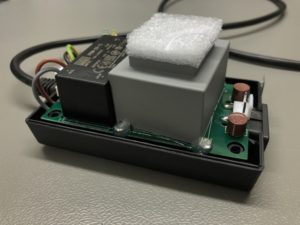
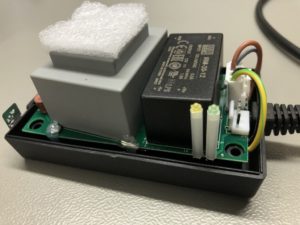
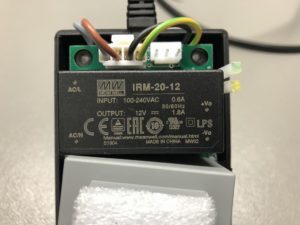
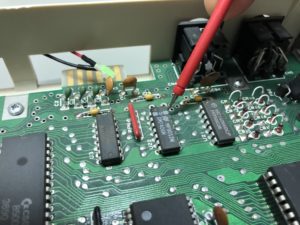
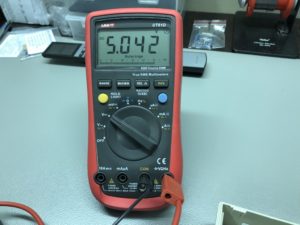
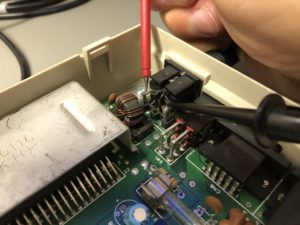
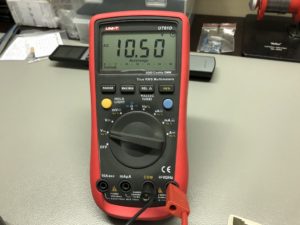
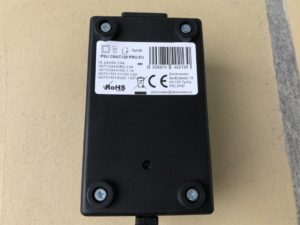
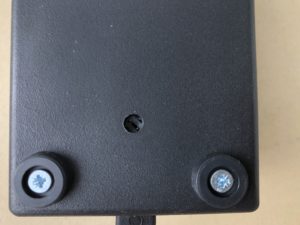
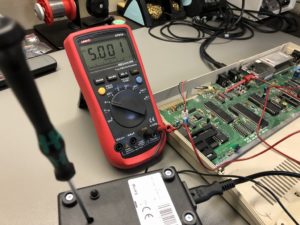
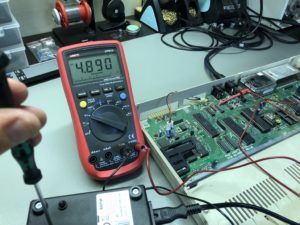
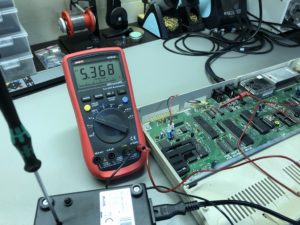
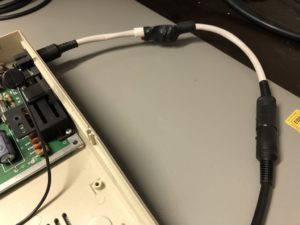
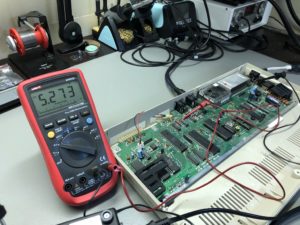
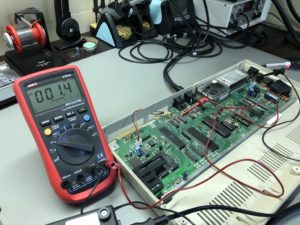
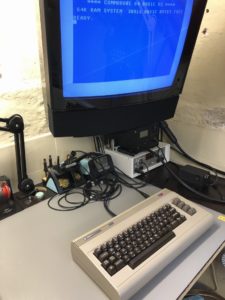
Thanks for you review, very interesting stuff for a newbie like myself getting into Commodore repairs. One question: “For the 5VDC measurements I used, among others, pin 14 of chip U22 7406 on the motherboard”. What is the reasoning behind measuring this specific IC? I have read about it before, and used it myself, but never actually understood why.
Hi joep, Good question! My understanding is that the 7406 at U22 (short boards) or U8 (long boards) inverts signals from the CIA that controls the bus interface of the Commodore 64. The signal from the 7406 chip (also known as the ‘output driver’) is then transmitted to a device on the bus. It is therefore a very central logic chip in the function of the Serial Interface of the C64. If you can measure voltages at this chip, large parts of the Commodore 64 is working correctly and you will get a correct voltage measurement from the power supply.
Nice job on the review and kudos for testing properly with a real C64 as load, which is necessary to get the real performance measurements, esp. for the 9v AC to the C64.
Potentially of interest to some folks: I just finished another look inside this PSU and a mod to increase its power (enough to power the C64 and an original 1541): Electroware C64 “2-in-1” PSU heavy-duty mod (30 watts DC) (link)
Did u measure the ripple ac voltage on the 5v dc and 12v dc lines? Really curious how low they are.
Hi Dylotic/Xenon, unfortunately I don’t have the hardware to properly measure the amount of ripple on the 5/12VDC lines. So I cannot give you an answer. Sorry 🙁
I bought the Pro version of this and was wondering cause I am new/old to commodore 64 about my 1541 drive has the built in power supply so I am kind of confused?
Hi thegenerallee86, you are absolutely right, the brown 1541 has a build in PSU. The later 1541-II version had an external PSU. The Electroware PRO PSU can power the latter type of disk drive 🙂
Hello. Does anyone in Australia make CPU for the c64″s?
darn…I just ordered the PRO PSU as well and have the old 1541 with built in PSU…hmm…is this built in PSU equally risky after all these years? If so, wouldn’t it be possible to open up the drive and bypass the PSU? I’d of course need to get the proper input socket then…which is I dunno what type…. Me too I’m new-old to the C64… I pulled mine from the attic after 35 years and it still works, tapes and all…
Hi Peter, I don’t know if it is possible to bypass the internal PSU of the 1541 diskette drive… I have not heard of that PSU breaking down as much as the original external C64 power supply 🙂